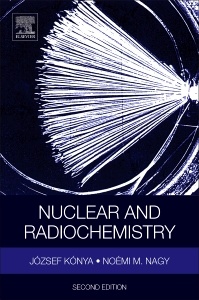Description
Nuclear and Radiochemistry (2nd Ed.)
Authors: Konya Jozsef, Nagy Noemi M.
Language: English
Subject for Nuclear and Radiochemistry:
480 p. · 19x23.3 cm · Paperback
Description
/li>Contents
/li>Readership
/li>Biography
/li>Comment
/li>
Nuclear and Radiochemistry, Second Edition, is a comprehensive and thorough reference that features the latest developments in the field, especially in radionuclide production, nuclear medicine and the application of natural radiotracers. Drawing on 40 years of experience in teaching and research, this revised edition explains the basic principles and applications of the primary areas of nuclear and radiochemistry. This new edition features completely revised chapters, in addition to 40 new illustrations plus case studies woven throughout the text. It will be helpful to students and researchers in chemistry, chemical engineering, environmental sciences and specialists working in all fields of radiochemistry.
The field of nuclear and radiochemistry is wide-reaching, with results having functions and use across a variety of disciplines. Separate chapters cover each main area of recent radiochemistry. This includes nuclear medicine and chemical aspects of nuclear power plants, namely the problems of nuclear wastes and nuclear analysis (both bulk and surface analysis), with the analytical methods based on the interactions of radiation with matter. Furthermore, special attention is paid to thermodynamics of radio-isotope tracer methods, the very diluted system (carrier-free radioactive isotopes) and the principles of chemical processes with unsealed radioactive sources.
1. Introduction2. Basic concepts3. Isotopes4. Radioactive decay5. Interaction of radiation with matter6. Nuclear reactions7. Nuclear energy production8. Radioactive tracer methods9. Physicochemical application of radiotracer methods10. Radio- and nuclear analysis11. Industrial application of radioisotopes (Lajos Baranyai)12. An Introduction to Nuclear Medicine (József Varga)13. Environmental radioactivity14. Detection and measurement of radioactivity
Students and researchers in physical chemistry, chemical engineering, and specialists working in fields with applications in radiochemistry such as agriculture, geology, medicine, or physics
Chemists (more specifically Physical Chemists) in research and industry. Secondary audience includes students taking related coursework at the upper undergraduate and graduate level.
Noémi M. Nagy is the professor of radiochemistry in the Isotope Laboratory of Colloid and Environmental Chemistry, University of Debrecen, Hungary. She received his M.Sc. and Ph.D. in radiochemistry at the University of Debrecen. She has a D.Sc. degree of agrochemistry from the Hungarian Academy of Sciences. She has approximately 30 years’ experience in nuclear and radiochemistry teaching. Her research interest is the study of the interfacial processes of natural sorbents, including soils, rocks, clay minerals mainly by radioactive tracer methods. Recently, she has dealt with the principal studies of nuclear waste storage. She has written or co-written numerous peer-reviewed articles and is the co-author four books in the fields of nuclear and radiochemistry as well as the interfacial chemistry of geological formations.
- Introduces fundamental concepts and practical applications, providing a thorough view of radiochemistry and nuclear chemistry
- Presents laboratory methods with unsealed radio-chemicals that can be applied in research and the lab Includes case studies sprinkled throughout the book to bring real-world applications to life
- Features 40 new illustrations to underscore key concepts
These books may interest you

Radiochemistry and Nuclear Chemistry 122.46 €



